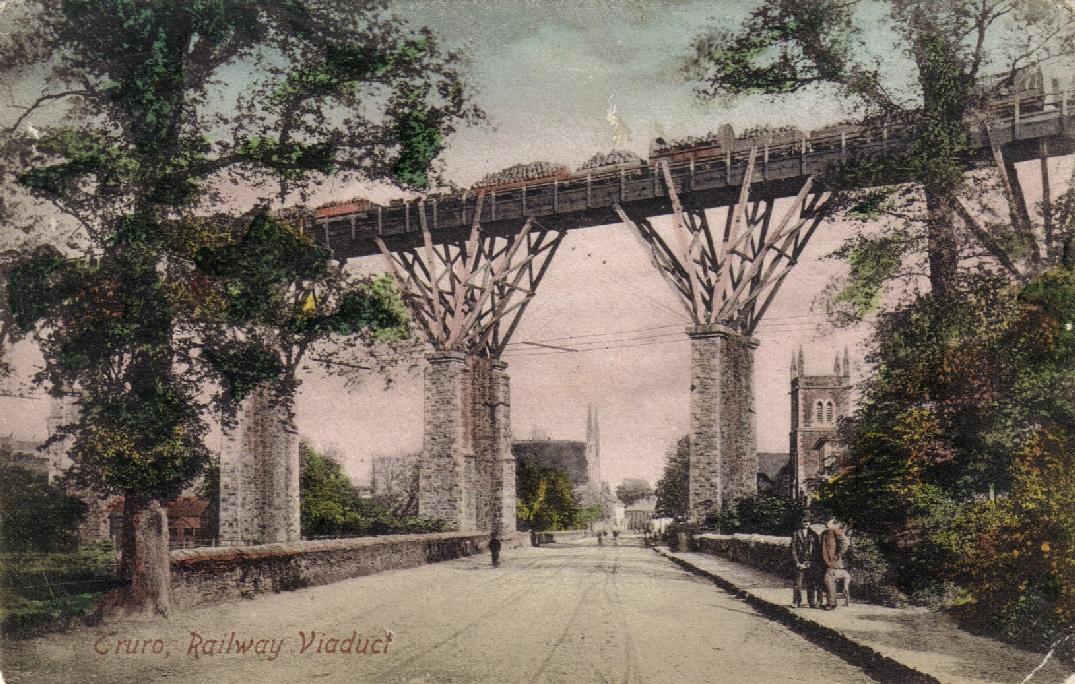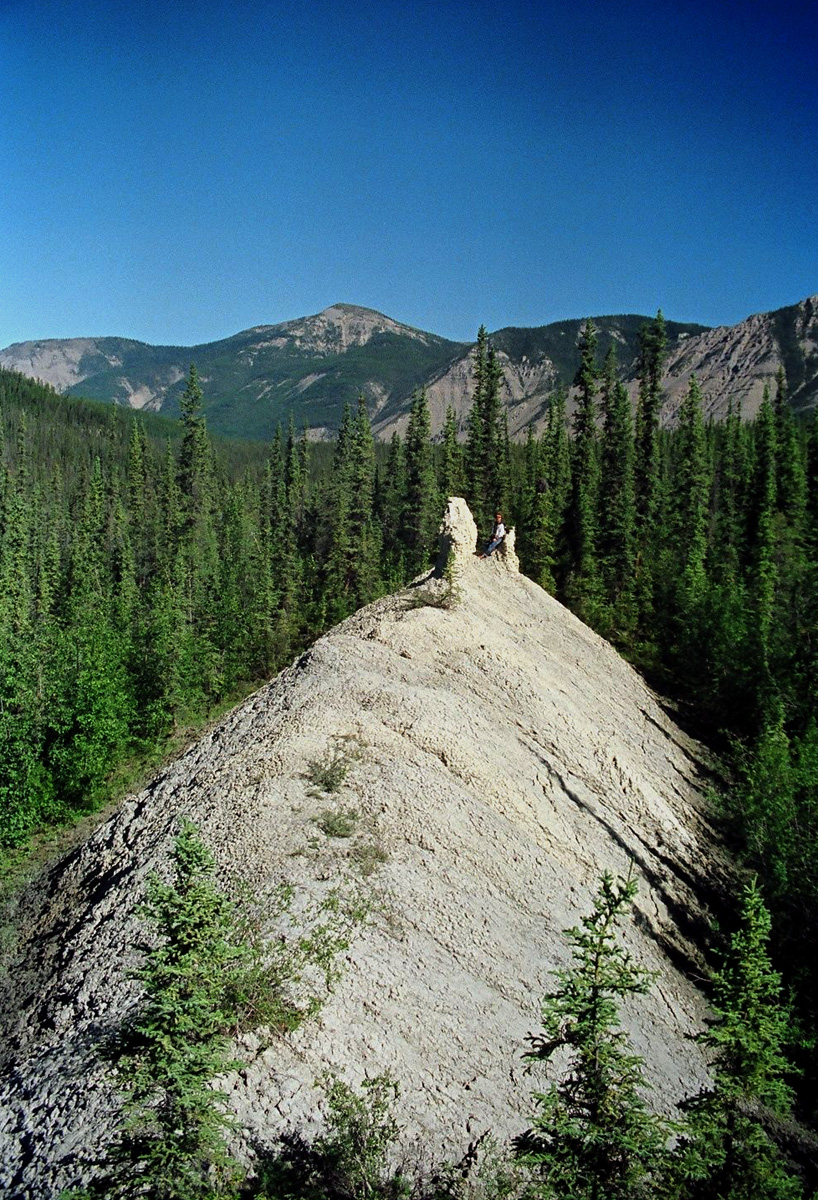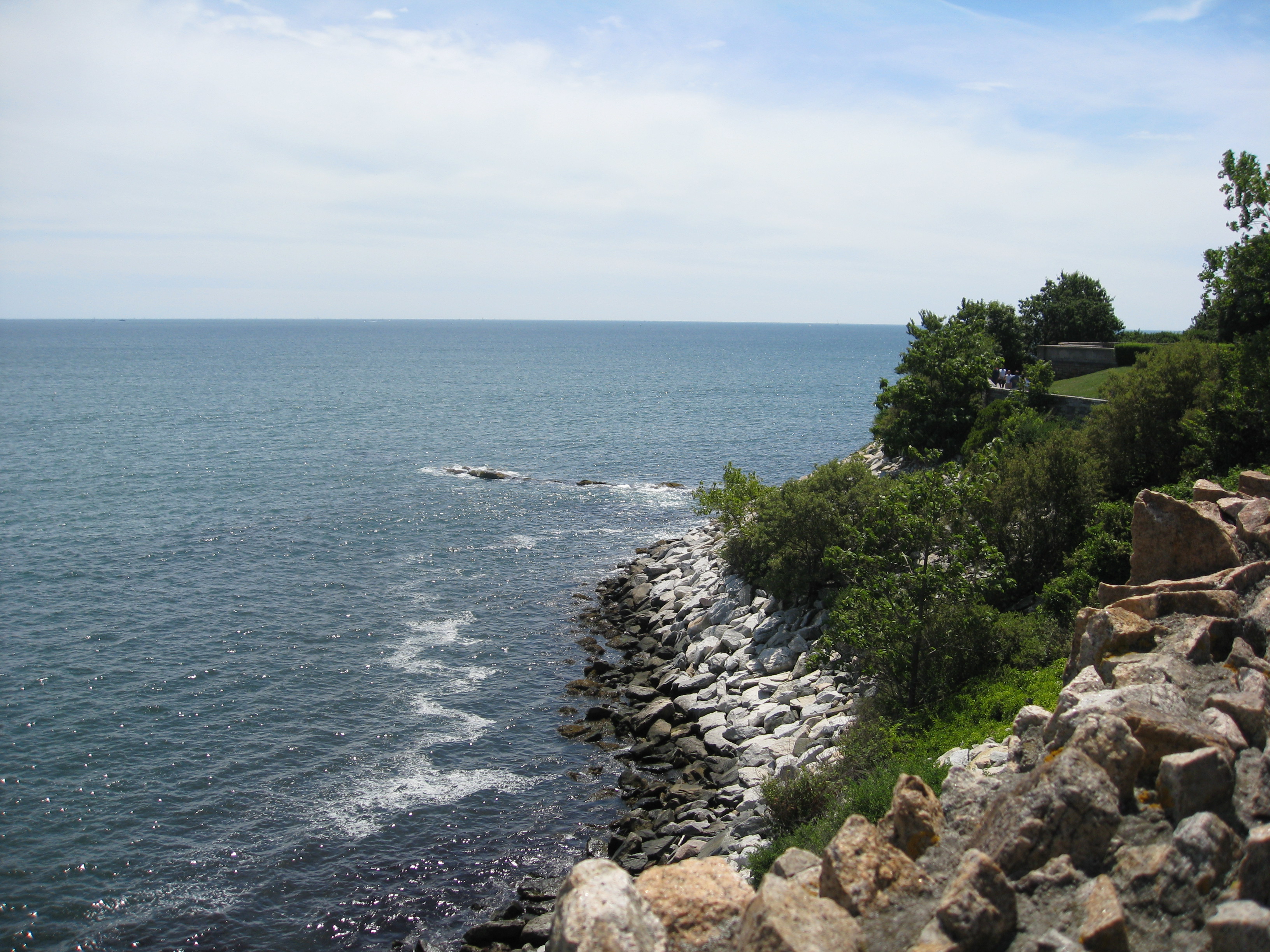|
Carnon Viaduct
The Carnon viaduct carries a railway line from Truro to Falmouth – now branded the Maritime Line – over the valley of the Carnon River in west Cornwall, United Kingdom. The viaduct is situated half-a-mile (800 metres) northeast of Perranwell station which is five miles (8 km) from the line's terminus at Falmouth and three miles (5 km) from its junction with the Cornish main line at Truro. The present nine-arch masonry viaduct replaced an earlier 19th-century structure designed by Isambard Kingdom Brunel for the Cornwall Railway. The original viaduct was opened to traffic when the line was extended from Truro to Falmouth in 1863 and had a timber deck supported by timber trestles springing from eleven masonry piers. It was long and high. The present viaduct is of roughly the same dimensions as the original. It was built by A E Farr CIvil Engineers of Westbury for the Great Western Railway as an entirely new structure immediately south of its predecesso ... [...More Info...] [...Related Items...] OR: [Wikipedia] [Google] [Baidu] |
Isambard Kingdom Brunel
Isambard Kingdom Brunel (; 9 April 1806 – 15 September 1859) was a British civil engineer who is considered "one of the most ingenious and prolific figures in engineering history," "one of the 19th-century engineering giants," and "one of the greatest figures of the Industrial Revolution, [who] changed the face of the English landscape with his groundbreaking designs and ingenious constructions." Brunel built dockyards, the Great Western Railway (GWR), a series of steamships including the first propeller-driven Transatlantic crossing, transatlantic steamship, and numerous important bridges and tunnels. His designs revolutionised public transport and modern engineering. Though Brunel's projects were not always successful, they often contained innovative solutions to long-standing engineering problems. During his career, Brunel achieved many engineering firsts, including assisting in the building of the Thames Tunnel, first tunnel under a Navigability, navigable river (th ... [...More Info...] [...Related Items...] OR: [Wikipedia] [Google] [Baidu] |
Cornwall Railway Viaducts
The Cornwall Railway company constructed a railway line between Plymouth and Truro in the United Kingdom, opening in 1859, and extended it to Falmouth in 1863. The topography of Cornwall is such that the route, which is generally east–west, cuts across numerous deep river valleys that generally run north–south. At the time of construction of the line, money was in short supply due to the collapse in confidence following the railway mania, and the company sought ways of reducing expenditure. On the advice of the Victorian railway engineer Isambard Kingdom Brunel, they constructed the river crossings in the form of wooden viaducts, 42 in total, consisting of timber deck spans supported by fans of timber bracing built on masonry piers. This unusual method of construction substantially reduced the first cost of construction compared to an all-masonry structure, but at the cost of more expensive maintenance. Replacement of the timber viaducts by all-masonry structures began in ... [...More Info...] [...Related Items...] OR: [Wikipedia] [Google] [Baidu] |
Caisson (engineering)
In geotechnical engineering, a caisson ( or ; borrowed from French ''caisson'', from Italian ''cassone'', meaning ''large box'', an augmentative of ''cassa'') is a watertight retaining structure used, for example, to work on the foundations of a bridge pier, for the construction of a concrete dam, or for the repair of ships. Caissons are constructed in such a way that the water can be pumped out, keeping the work environment dry. When piers are being built using an open caisson, and it is not practical to reach suitable soil, friction pilings may be driven to form a suitable sub-foundation. These piles are connected by a foundation pad upon which the column pier is erected. Caisson engineering has been used at least since the 18th century, and was notably used in the construction of the Brooklyn Bridge, which was completed in 1883. Types To install a caisson in place, it is brought down through soft mud until a suitable foundation material is encountered. While bedrock is pr ... [...More Info...] [...Related Items...] OR: [Wikipedia] [Google] [Baidu] |
Mining In Cornwall
Mining in Cornwall and Devon, in the South West England, southwest of England, began in the early Bronze Age, around 2150 BC. Tin, and later copper, were the most commonly extracted metals. Some tin mining continued long after the mining of other metals had become unprofitable, but ended in the late 20th century. In 2021, it was announced that a new mine was extracting Lithium-ion battery, battery-grade lithium carbonate, more than 20 years after the closure of the last South Crofty tin mine in Cornwall in 1998. Historically, tin and copper as well as a few other metals (e.g. arsenic, silver, and zinc) have been mined in Cornwall and Devon. Tin deposits still exist in Cornwall, and there has been talk of reopening the South Crofty tin mine. In addition, work has begun on re-opening the Drakelands Mine, Hemerdon tungsten and tin mine in south-west Devon. In view of the economic importance of mines and quarries, geological studies have been conducted; about forty distinct minera ... [...More Info...] [...Related Items...] OR: [Wikipedia] [Google] [Baidu] |
Silt
Silt is granular material of a size between sand and clay and composed mostly of broken grains of quartz. Silt may occur as a soil (often mixed with sand or clay) or as sediment mixed in suspension with water. Silt usually has a floury feel when dry, and lacks plasticity when wet. Silt also can be felt by the tongue as granular when placed on the front teeth (even when mixed with clay particles). Silt is a common material, making up 45% of average modern mud. It is found in many river deltas and as wind-deposited accumulations, particularly in central Asia, north China, and North America. It is produced in both very hot climates (through such processes as collisions of quartz grains in dust storms) and very cold climates (through such processes as glacial grinding of quartz grains.) Loess is soil rich in silt which makes up some of the most fertile agricultural land on Earth. However, silt is very vulnerable to erosion, and it has poor mechanical properties, making construc ... [...More Info...] [...Related Items...] OR: [Wikipedia] [Google] [Baidu] |
Mudflats
Mudflats or mud flats, also known as tidal flats or, in Ireland, slob or slobs, are coastal wetlands that form in intertidal areas where sediments have been deposited by tides or rivers. A global analysis published in 2019 suggested that tidal flat ecosystems are as extensive globally as mangroves, covering at least of the Earth's surface. / They are found in sheltered areas such as bays, bayous, lagoons, and estuaries; they are also seen in freshwater lakes and salty lakes (or inland seas) alike, wherein many rivers and creeks end. Mudflats may be viewed geologically as exposed layers of bay mud, resulting from deposition of estuarine silts, clays and aquatic animal detritus. Most of the sediment within a mudflat is within the intertidal zone, and thus the flat is submerged and exposed approximately twice daily. A recent global remote sensing analysis estimated that approximately 50% of the global extent of tidal flats occurs within eight countries (Indonesia, China, Aust ... [...More Info...] [...Related Items...] OR: [Wikipedia] [Google] [Baidu] |
Intertidal
The intertidal zone, also known as the foreshore, is the area above water level at low tide and underwater at high tide (in other words, the area within the tidal range). This area can include several types of habitats with various species of life, such as seastars, sea urchins, and many species of coral with regional differences in biodiversity. Sometimes it is referred to as the ''littoral zone'' or '' seashore'', although those can be defined as a wider region. The well-known area also includes steep rocky cliffs, sandy beaches, bogs or wetlands (e.g., vast mudflats). The area can be a narrow strip, as in Pacific islands that have only a narrow tidal range, or can include many meters of shoreline where shallow beach slopes interact with high tidal excursion. The peritidal zone is similar but somewhat wider, extending from above the highest tide level to below the lowest. Organisms in the intertidal zone are adapted to an environment of harsh extremes, living in wate ... [...More Info...] [...Related Items...] OR: [Wikipedia] [Google] [Baidu] |
Restronguet Creek
Restronguet Creek is a tidal ria in south Cornwall, United Kingdom. It is a tributary of Carrick Roads, the estuary of the River Fal, and is situated approximately four miles (6.5 km) south of Truro and three miles (5 km) north of Falmouth. Ordnance Survey: Landranger map sheet 204 ''Truro & Falmouth'' The creek is approximately two miles (3 km) long from its Normal Tidal Limit (NTL) to its mouth and half-a-mile (800 metres) across at its widest point. It discharges into Carrick Roads at Restronguet Point through a narrow channel known locally as 'the gut'. Restronguet Creek Society website. Retrieved May 2010 Restronguet Creek forms the boundary between the es of [...More Info...] [...Related Items...] OR: [Wikipedia] [Google] [Baidu] |
Great Western Railway
The Great Western Railway (GWR) was a British railway company that linked London London is the capital and List of urban areas in the United Kingdom, largest city of England and the United Kingdom, with a population of just under 9 million. It stands on the River Thames in south-east England at the head of a estuary dow ... with the southwest, west and West Midlands (region), West Midlands of England and most of Wales. It was founded in 1833, received its enabling Act of Parliament on 31 August 1835 and ran its first trains in 1838 with the initial route completed between London and Bristol in 1841. It was engineered by Isambard Kingdom Brunel, who chose a broad gauge of —later slightly widened to —but, from 1854, a series of Consolidation (business), amalgamations saw it also operate Standard gauge, standard-gauge trains; the last broad-gauge services were operated in 1892. The GWR was the only company to keep its identity through the Railways Act 1921, which ama ... [...More Info...] [...Related Items...] OR: [Wikipedia] [Google] [Baidu] |
Cornwall Railway
The Cornwall Railway was a broad gauge railway from Plymouth in Devon to Falmouth in Cornwall, England, built in the second half of the nineteenth century. It was constantly beset with shortage of capital for the construction, and was eventually forced to sell its line to the dominant Great Western Railway. The Cornwall Railway was famous for building the majestic Royal Albert Bridge over the River Tamar and, because of the difficult terrain it traversed, it had a large number of viaducts, built as timber trestles because of the shortage of money. They proved to be iconic structures, but were a source of heavy maintenance costs, eventually needing to be reconstructed in more durable materials. Its main line was the key route to many of the holiday destinations of Cornwall, and in the first half of the 20th century it carried holidaymakers in summer, as well as vegetables, fish and cut flowers from Cornwall to markets in London and elsewhere in England. The section from Tr ... [...More Info...] [...Related Items...] OR: [Wikipedia] [Google] [Baidu] |
Masonry
Masonry is the building of structures from individual units, which are often laid in and bound together by mortar; the term ''masonry'' can also refer to the units themselves. The common materials of masonry construction are bricks, building stone such as marble, granite, and limestone, cast stone, concrete blocks, glass blocks, and adobe. Masonry is generally a highly durable form of construction. However, the materials used, the quality of the mortar and workmanship, and the pattern in which the units are assembled can substantially affect the durability of the overall masonry construction. A person who constructs masonry is called a mason or bricklayer. These are both classified as construction trades. Applications Masonry is commonly used for walls and buildings. Brick and concrete block are the most common types of masonry in use in industrialized nations and may be either load-bearing or non-load-bearing. Concrete blocks, especially those with hollow cores, offer v ... [...More Info...] [...Related Items...] OR: [Wikipedia] [Google] [Baidu] |









